Abstract
This paper provides theoretical and experimental discussions on the characteristics of the modular multilevel converter (MMC) when phase-shifted carrier sinusoidal pulse-width modulation (PSC-SPWM) is applied. Harmonic-cancellation characteristics of output voltage and circulating current are analyzed on the basis of a general implementation of PSC-SPWM with two freedom displacement angles. Five available PSC-SPWM schemes with different carrier displacement angles were obtained, and a detailed performance comparison about output voltage and circulating current harmonic characteristics is presented. On the basis of the equivalent circuit with ideal transformer representation of the SMs, capacitor voltages affected by PSC-SPWM schemes are also briefly analyzed. The proposed PSC-SPWM schemes can unify two different cases of odd and even SM situations for output voltage and circulating current harmonic minimization, respectively. Lastly, the optimal schemes for practical MMC application were verified by simulation and experiments on an MMC prototype.
1. Introduction
The modular multilevel converter (MMC) has been widely studied because it presents great advantages such as a transformer-less and modular structure, common DC bus, and good harmonic characteristics [1,2,3]. These advantages make MMC the most attractive topology for various medium- and high-voltage, high-power applications, such as high-voltage direct-current (HVDC) transmission systems [4,5], static synchronous compensators (STATCOM) [6,7], high-voltage isolated DC/DC [8], and medium-voltage motor drive [9,10,11,12].
The MMC allows for the flexible selection of inserted submodules (SMs), so there are various modulation methods that directly affect the harmonic characteristics of output voltage and circulating current. The staircase wave-modulation methods in [13] are preferable in applications that require an extremely high number of SMs, such as HVDC applications. Some optimization schemes for reducing power losses are mentioned in [14,15]. The selective harmonic eliminating modulation technology [16], space vector pulse-width modulation (SVPWM) [17,18], and phase-shifted carrier sinusoidal pulse-width modulation (PSC-SPWM) technology [19,20,21,22,23] are also considered as modulation methods for MMC applications that need fewer submodules. Among these methods, PSC-SPWM technology is more used for fewer SMs. Each power unit has the same switching frequency with PSC-SPWM, which is a benefit for heat-dissipation structure design. When PSC-SPWM is applied, the output voltage of MMC, as shown in Figure 1, has or levels with different displacement-angle assignments between the carriers of each SM [21]. The displacement angle affects the harmonic characteristics of output voltage and circulating current. An available implementation scheme of PSC-SPWM technology for MMC was presented in [22]. The displacement angle is set to when N is even, and 0 when N is odd for maximal harmonic cancellation of output voltage. On the other hand, to achieve the greatest harmonic cancellation of circulating current, the displacement angle should be when N is odd, and 0 when N is even. However, the angle irregularly changes according to the parity of SM number. Furthermore, how the displacement angle between the adjacent SMs in the same arm influences the performance of harmonics and the voltage-balancing issue of capacitors is not considered. Energy distribution is only relatively balanced between submodules when the right displacement angle is selected. Four available PSC-SPWM schemes were presented with performance comparison about output voltage and circulating current harmonic characteristics in our previous paper [23], whereas the selection of displacement angle does not give theoretical derivation.
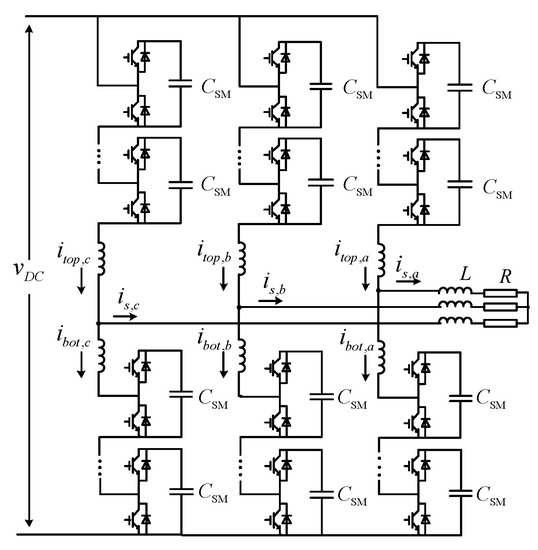
Figure 1.
Structure of three-phase modular multilevel converter (MMC).
This paper presents a theoretical derivation of displacement-angle selection based on harmonic-cancellation characteristics. All possible solutions for harmonic cancellation were obtained, and the optimal PSC-SPWM schemes were selected on the basis of harmonic-cancellation characteristics and voltage stability. The proposed PSC-SPWM schemes unify two different cases of odd and even SM situations. The rest of the paper is organized as follows: In Section 2, the MMC topology is introduced, and the mathematical model is established. Then, a general PSC-SPWM scheme with two freedom displacement angles (displacement angle between adjacent SMs in the same arm, and the displacement angle between top and bottom SMs) is presented in Section 3, and optimal PSC-SPWM schemes for MMC were obtained on the basis of mathematical analysis of the harmonic-cancellation characteristics of output voltage and circulating current affected by the displacement angles. Moreover, the capacitor voltage of SMs affected by displacement angles was analyzed on the basis of the equivalent circuit with the ideal transformer representation of the SMs in this section. Section 4 gives the simulation and experiment results with a detailed performance comparison about the characteristics of output voltage and circulating current, which show that the selected displacement-angle assignment was the most suitable PSC-SPWM scheme for practical MMC application. Lastly, conclusions are summarized in Section 5.
2. Basic MMC Operational Principle
2.1. MMC Structure
A schematic diagram of a three-phase MMC is shown in Figure 1. The main circuit consists of six arms. Each arm is composed of N half-bridge SMs, which are connected with a separated arm inductor in series. Each SM is formed by a DC capacitor and two power switches. Three-phase RL load is respectively connected to the midpoint of three phases.
2.2. Model of MMC
The mathematical model of MMC can be obtained by Kirchhoff’s voltage law and Kirchhoff’s current law as
where , are voltages across N top SMs and bottom SMs in phase j (), respectively. , are the output voltage and current of phase j , respectively. is arm inductance, and is the DC-link voltage. The circulating current circulates through both the top and bottom arms of phase j, which is expressed as
where , are the top and bottom arm current of phase j, respectively.
The voltage across arm inductors is :
For the SMs of MMC, the output voltage of the kth SM in the top and bottom arms can be expressed by , respectively:
where , and , are the capacitor voltage and switching function of kth SM of the top and bottom arms, respectively.
The dynamic equation of SM capacitors can be obtained as
According to (1), (4), and (5), one phase circuit of MMC can be redrawn by the equivalent circuit on the basis of the ideal transformer representation of SMs [24], as shown in Figure 2. The notation of turns-ratio term is abbreviated as the switching function of SMs, which fully represents the switching action. On the basis of the equivalent circuit, energy was transferred from the DC side to the AC side through SM capacitors, which acted as intermediate storage elements. In this equivalent circuit, external and internal characteristics of the MMC could be reflected well.
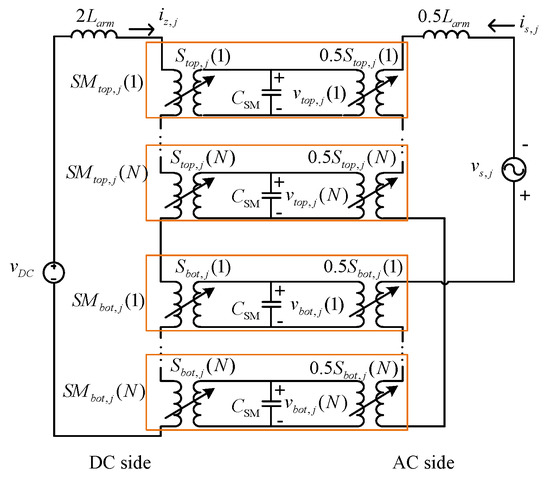
Figure 2.
Equivalent circuit of single MMC phase.
3. Phase-Shifted PWM Schemes for MMC
In general, the PSC-SPWM scheme of MMC (N SMs each arm) with two freedom displacement angles is shown in Figure 3. Each SM is assigned with a specific reference signal and a triangular carrier with a displacement angle. The state of the SM is determined by the relationship between reference signal and carrier. When the reference is larger than the carrier value, the corresponding switching function or equals to 1; when the reference is smaller than the carrier value, the corresponding switching function or equals to 0.
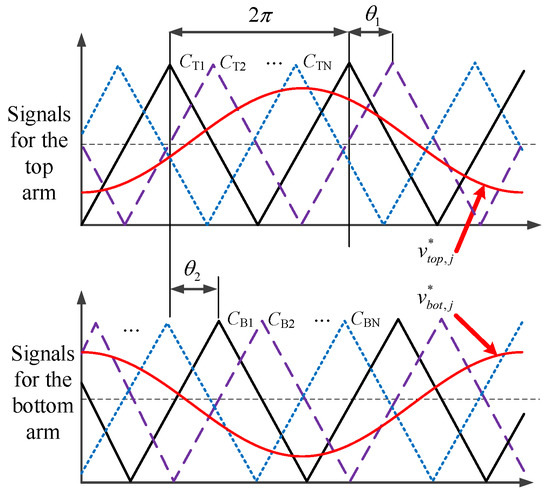
Figure 3.
General MMC phase-shifted carrier sinusoidal pulse-width modulation (PSC-SPWM) schemes.
, are the displacement angles between the adjacent carriers of the same arm, and the displacement angle between the carriers of the top and bottom arms, respectively. Reference voltages are given as
where M is the modulation index, is the fundamental angle frequency, is the phase angle, and is the voltage of DC bus.
Each SM corresponding to a specific triangular carrier with different displacement angle. The general carrier function of the top and bottom SMs can be calculated as:
3.1. Fourier Series Representation of Switching Functions
The double Fourier series based on analysis in [25] is presented to obtain the harmonic feature of output voltage and circulating current of MMC. In (7) and (8), there are two freedom displacement degrees, and , which constitute different PSC-SPWM schemes. The principle of how and affect the harmonics of output voltage and circulating current is presented in this section.
From (6–8), the switching function can be expressed by Fourier representation as
where m is carrier index variable (m = 1, 2, … , ∞), n is the baseband index variable (n = , … , −1, 0, 1, … , ∞), and is the Bessel coefficient.
For simplicity, it was assumed that all the capacitor voltage of SMs are naturally balanced and the voltage fluctuation is ignored. From (1), (9), and (10), the equivalent output voltage of phase j can be obtained as
From (11), the harmonic characteristic of output voltage is affected by the following items, which are the function of , and N:
Voltage across the arm inductors of phase j can be obtained as
Similarly, the harmonic characteristic of voltage across the arm inductors is affected by
3.2. Harmonic-Cancellation Characteristics of MMC with PSC-SPWM
According to (12) and (14), if one of , and is equal to 0, the corresponding output-voltage harmonic components can be completely eliminated. The corresponding circulating current harmonic components can be completely eliminated if one of , and is equal to 0 in the same way. Specifically, if index m is odd/even, and index n is odd/even, equals to 0 in the expression of both Equations (11) and (13). As a result, odd side-band harmonics are eliminated in the output waveform and voltage of arm inductors around the odd carrier frequency multiples and the even side-band harmonics are eliminated in the output waveform and voltage of arm inductors around the even carrier-frequency multiples.
Harmonic-cancellation characteristics of , and are affected by and . Item can eliminate the harmonics of the whole group with proper , and the relationship between and is shown in Figure 4. If equals to , all the even multiples carrier-frequency harmonic groups except those at -multiples and its integral multiple are eliminated. For example, the harmonics of group and are eliminated when . The harmonics of group , and are eliminated when . If equals to , all multiples carrier-frequency harmonic groups except those at N-multiples and its integral multiples are eliminated. For example, the harmonics of group , , and are eliminated when . The harmonics of group , , , , and are eliminated when .
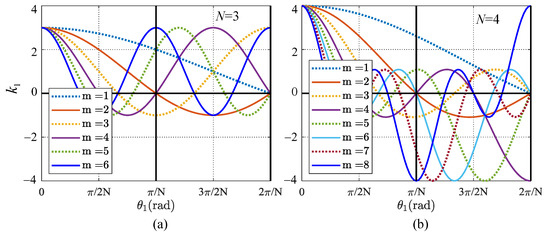
Figure 4.
Harmonics of group cancellation characteristics with PSC-SPWM schemes. (a) . (b) .
After eliminating the harmonics of some whole group with proper , proper displacement angle can be selected to eliminate more harmonic components. The harmonic components of circulating current are the same as the voltage across the arm inductor. However, according to the relationship of trigonometric functions, in (12) and in (14) are completely different. For a particular harmonic group , output-voltage harmonics and the circulating current harmonic vary with at the completely opposite tendency. Displacement angle should be selected to obtain a zero or item coordinate with the harmonic-cancellation capability of to achieve maximal harmonic elimination of output voltage or circulating current, respectively.
For MMC, output voltage with lower harmonic distortion means smaller and lower-cost filters, and better output characteristics, especially when N is small (e.g., in motor drive applications). On the other hand, the harmonics of circulating current causes higher loss and current stress. For a great number of SM applications (e.g., HVDC application), the harmonics of circulating current become the main problem. In this paper, five potential PSC-SPWM schemes (PSC1 to PSC5) for MMC that achieve maximal voltage harmonic elimination or maximal circulating current harmonic elimination are presented, as shown in Figure 5. They are described with a modulation wave frequency of 50 Hz, a carrier frequency of 200 Hz, and four SMs in each arm. Displacement angle , of each scheme is given as follows.
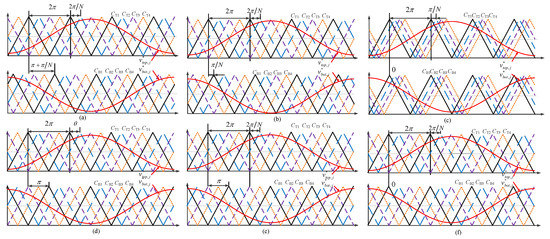
Figure 5.
Proposed PSC-SPWM schemes for MMC that achieve maximal voltage harmonic elimination or maximal circulating current harmonic elimination. (a) PSC-SPWM1. (b) PSC-SPWM2. (c) PSC-SPWM3. (d) PSC-SPWM4. (e) PSC-SPWM4 when . (f) PSC-SPWM5.
PSC1:
PSC2:
PSC3:
PSC4:
PSC5:
where PSC2 and PSC5 were mentioned in [22]. PSC1 and PSC3 were first proposed in [23], and PSC4 was added into this paper for discussion. Theoretically, PSC1, PSC2, and PSC3 can achieve maximal voltage harmonic elimination, and PSC4 and PSC5 can achieve maximal circulating current harmonic elimination. Compared with PSC2 and PSC5, the proposed PSC1,PSC3, and PSC4 unify two different cases of odd and even SM situations.
For a specific index m, if both even n and odd n can result in a zero or item, the corresponding harmonic groups are eliminated in output voltage. Similarly, if both even n and odd n can result in a zero or item, the corresponding harmonic groups are eliminated in circulating current. For PSC1 and PSC2, all harmonics except those even side-band harmonics around the -multiples carrier frequency and the odd side-band harmonics around the -multiples carrier frequency remain with . When the m summation index is equal to , and of PSC1 and PSC2, it can be represented as follows.
PSC1:
In (20), both even n and odd n can result in an even or even , which obtains a zero or item. In other words, the harmonics of -multiples carrier frequency are totally eliminated in output voltage with PSC1, resulting in maximal voltage harmonic elimination.
PSC2:
In (21), both even n and odd n can result in an even or when N is even, and an even or even n when N is odd, which obtains a zero or item. As a result, the harmonics of -multiples carrier frequency are totally eliminated in output voltage with PSC2 the same with PSC1.
On the other hand, when the m summation index is equal to , the and of PSC1 and PSC2 can be represented as
PSC1:
PSC2:
In (22), both even n and odd n can result in an even or odd , which obtains a zero or item. Similarly, in (23), both even n and odd n can result in an even or odd when N is even, and an even or odd n when N is odd, which obtains a zero or item too. As a result, the extra harmonics of group -multiples carrier frequency are eliminated in circulating current with PSC1 or PSC2.
For PSC3, all harmonics of odd multiples and -multiples carrier frequency are remained when . When the m summation index is equal to , and can be represented as
PSC3:
In (24), both even n and odd n can result in a zero or item. As a result, all odd multiples carrier-frequency harmonic groups are eliminated in output voltage with PSC3, resulting in maximal voltage harmonic elimination, the same as in PSC1 and PSC2.
On the other hand, when the m summation index is equal to , the and of PSC3 can be represented as
PSC3:
Both odd n and even n can result in a zero or . The extra harmonics of group -multiples carrier frequency are eliminated in circulating current with PSC3.
For PSC4, and can be represented as
PSC4:
All multiples carrier-frequency harmonic groups are eliminated in the circulating current with PSC4, while and can be represented as
PSC4:
Only even side-band harmonics around the even multiples and the odd side-band harmonics are around the odd multiples are eliminated in the output voltage with PSC4 when and .
For PSC5, when the m summation index is equal to , and can be represented as
PSC5:
All the harmonics of multiples carrier frequency are eliminated in the circulating current with a zero item or when PSC5 is applied.
On the other hand, when the m summation index is equal to , and can be represented as
PSC5:
There are no extra harmonics that can be eliminated in output voltage with PSC5.
From the above analysis, the conclusion is that only odd side-band harmonics around -multiples carrier frequency are retained in output voltage with PSC1, PSC2, and PSC3 applied. The extra harmonic group of -multiples carrier frequency is eliminated in circulating current with PSC1 and PSC2, while all even side-band harmonics around odd multiples carrier frequency remain with PSC3. All carrier-frequency harmonics are eliminated in the circulating current with both PSC4 and PSC5 applied. Simultaneously, maximal extra harmonic cancellation in output voltage can be obtained with PSC4 when , which is equivalent to PSC5.
Carrier angles of each SM for five PSC-SPWM schemes when (odd number SMs example) and (even number SMs example) are listed in Figure 6 and Figure 7. PSC1, PSC2, and PSC3 are the minimal voltage harmonic schemes. PSC4 (when ) and PSC5 are the minimal circulating current harmonic schemes. Considering that the status of each SM in the same arm is identical, PSC1 and PSC2, PSC4, and PSC5 are equivalent except that SMs in the bottom arm corresponding to the top arms are different. SMs with the same status (carrier angle) are filled with the same color and connected by red arrows. Obviously, the proposed PSC1 and PSC4 could automatically distribute the carrier angle.
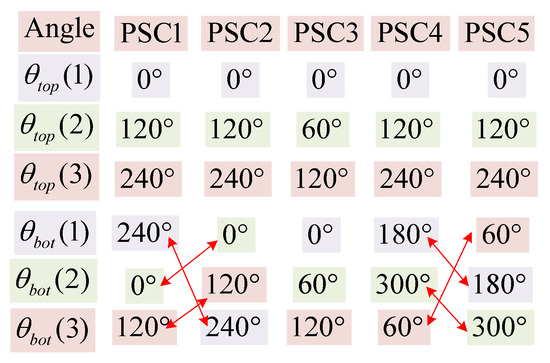
Figure 6.
Carrier angles of each submodule (SM) for five PSC-SPWM schemes when .
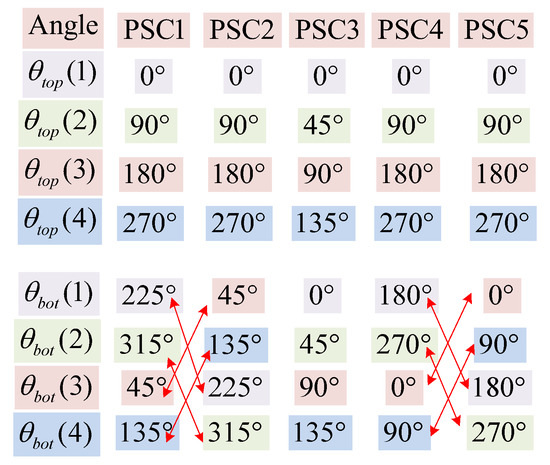
Figure 7.
Carrier angles of each SM for five PSC-SPWM schemes when .
The specific PSC-SPWM scheme is determined according to the number of SMs and aforementioned harmonic-cancellation characteristics analysis. Considering the harmonic performance of both output voltage and circulating current, the optimal maximal output voltage and circulating current harmonic elimination schemes are PSC1 and PSC4 when , respectively, for which implementation does not need irregular change with parity of submodule number.
3.3. Capacitor Voltage of SMs Affected by PSC-SPWM Schemes
The above analysis is based on the assumption that all SM capacitor voltages are naturally balanced and voltage fluctuations are ignored. However, SM voltage is also affected by modulation methods. From (5), capacitor voltage varies with switching function, load current, and circulating current. The voltage fluctuation of SM capacitors in one carrier cycle is given as
where is a fundamental period. SM capacitor voltage is affected by switching function, circulating current and the load current. Natural balancing of the 2-Cell modular multilevel converter with traditional PSC-SPWM schemes was discussed in [24], which is closely related to harmonic distribution of output current and circulating current. If the switching function and circulating current contain the same harmonic components, or the switching function and phase current contain the same harmonic components in the orthogonal trigonometric system, the right side of (21) could contain a non-negligible DC component. Voltage variation in a fundamental cycle is not equal to zero, and the capacitor voltage of each SM deviates from the rated value.
According to the above analysis, even side-band harmonics around the carrier frequency are remained in circulating current with PSC3. However, these harmonic components are also contained in switching functions and . In an orthogonal trigonometric function system, these large harmonic components could cause a non-negligible DC current in SM capacitors, which results in voltage deviation. The capacitor-voltage deviation phenomenon is verified by simulation and experiments in next section. Similarly, even side-band harmonics around the carrier frequency remain in output current with PSC4 when , which also results in voltage deviation. Therefore, from the perspective of the effect on capacitor voltage, should be met for PSC-SPWM schemes.
4. Simulation and Experiment Results
Simulation and experiment results were obtained to verify the analysis of the PSC-SPWM strategy in a three-phase MMC with four half-bridge SMs. Simulation results were obtained from MATLAB/Simulink, and the experiment results were obtained from a low-power laboratory prototype as shown in Figure 8. A digital-signal processor (DSP; TI TMS32028335) was used to generate the reference voltage, while two field-programmable gate arrays (FPGAs; Spartan-6 XC6SLX9)were adopted to generate the triangular carriers and data processing, respectively. PWM signals were transmitted to SMs via optical fibers. The main parameters of the converter are given in Table 1.
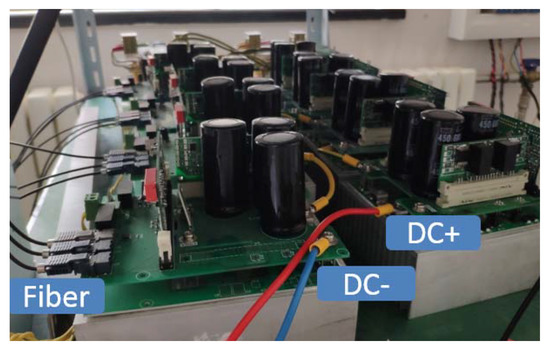
Figure 8.
Laboratory prototype.

Table 1.
MMC parameters.
4.1. Simulation Results
Figure 9, Figure 10, Figure 11, Figure 12 and Figure 13 shows the simulation results of output-phase voltage with five PSC-SPWM strategies. The equivalent output-phase voltage reached levels with PSC1, PSC2, and PSC3, which had maximal output-voltage harmonic-cancellation ability, and voltage total harmonic distortion (THD) was 14.7% with the main odd side-band harmonics around -multiples carrier frequency and its integral multiple harmonic groups. The simulation results of PSC4, when , and PSC5 are shown in Figure 12 and Figure 13, respectively. Both of these PSC-SPWM schemes had the same output characteristics. Equivalent output voltage reached levels, and voltage THD was much larger than that of PSC1, PSC2, and PSC3, with 36.223%. The main harmonic components were around N times the carrier frequency and its integral multiples.

Figure 9.
Theoretical output voltage of PSC1. (a) Waveform of equivalent output-phase voltage; (b) fast Fourier transform (FFT) analysis.
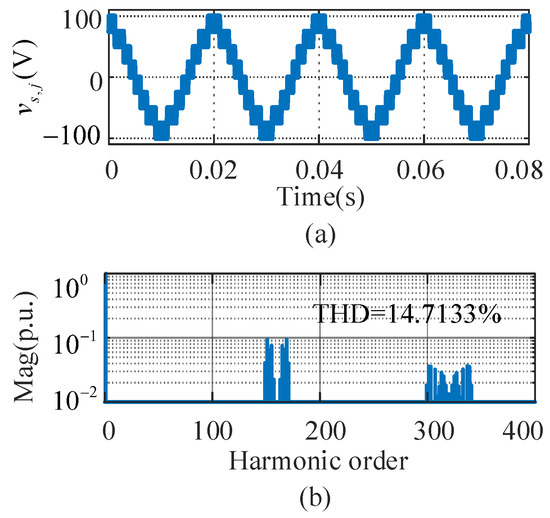
Figure 10.
Theoretical output voltage of PSC2. (a) Waveform of equivalent output-phase voltage; (b) FFT analysis.
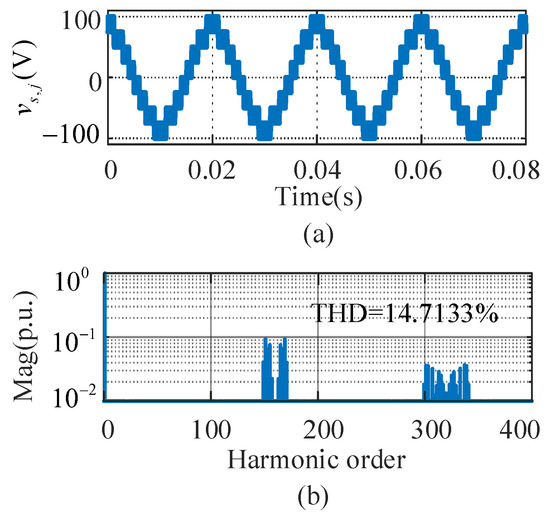
Figure 11.
Theoretical output voltage of PSC3. (a) Waveform of equivalent output-phase voltage; (b) FFT analysis.
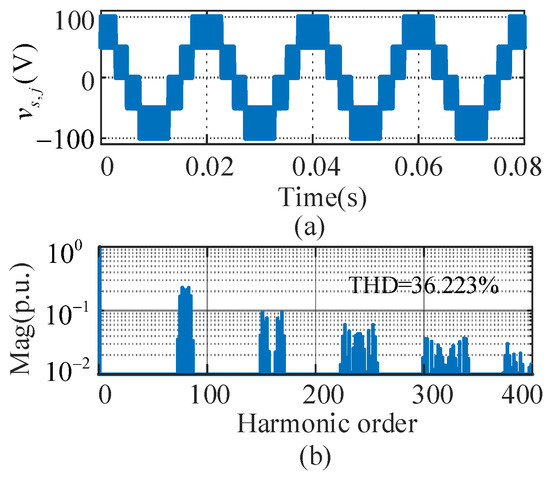
Figure 12.
Theoretical output voltage of PSC4. (a) Waveform of equivalent output-phase voltage; (b) FFT analysis.
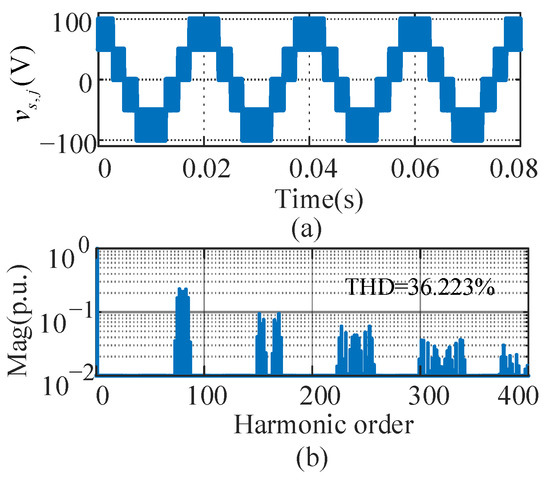
Figure 13.
Theoretical output voltage of PSC5. (a) Waveform of equivalent output-phase voltage; (b) FFT analysis.
Simulation results of circulating current under five PSC-SPWM strategies are shown in Figure 14, Figure 15, Figure 16, Figure 17 and Figure 18. The circulating current included the extra N-multiples carrier frequency and its odd multiple harmonic groups with PSC1 and PSC2 applied, all odd carrier multiple harmonic groups remained with PSC3 applied. The circulating current was mainly composed of the DC component and the secondary component with PSC4 when and PSC5. All high-frequency harmonics were completely eliminated, with maximal harmonic-cancellation ability. On the other hand, the harmonic characteristic of output-phase voltage was decreased. Crculating current harmonic and output-voltage harmonics varied with at a completely opposite tendency.
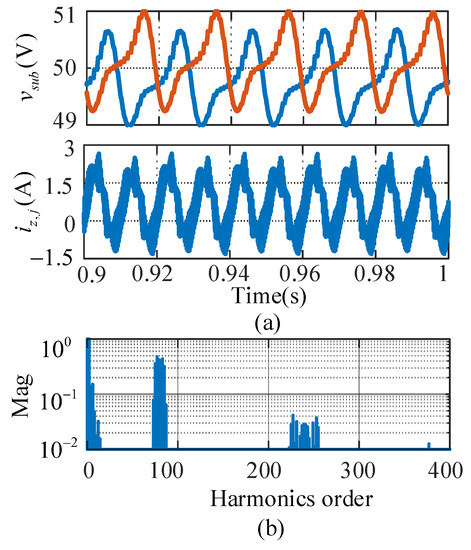
Figure 14.
Simulation results of PSC1. (a) Capacitor voltage of SMs and circulating current. (b) FFT analysis of circulating current.
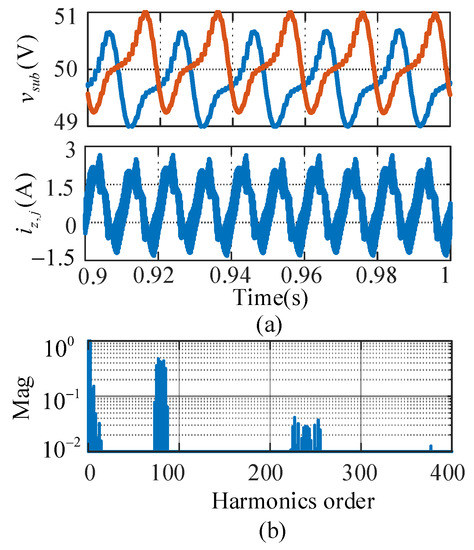
Figure 15.
Simulation results of PSC2. (a) Capacitor voltage of SMs and circulating current. (b) FFT analysis of circulating current.
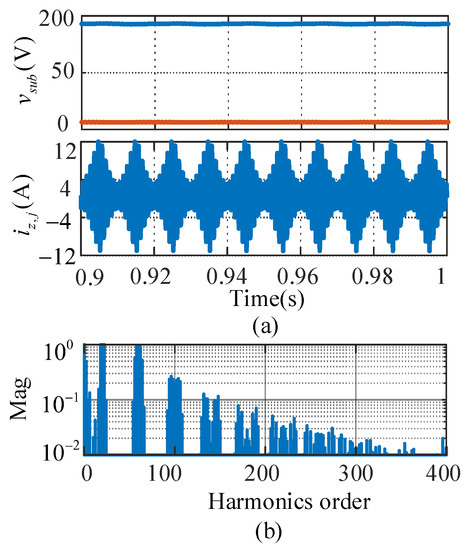
Figure 16.
Simulation results of PSC3. (a) Capacitor voltage of SMs and circulating current. (b) FFT analysis of circulating current.
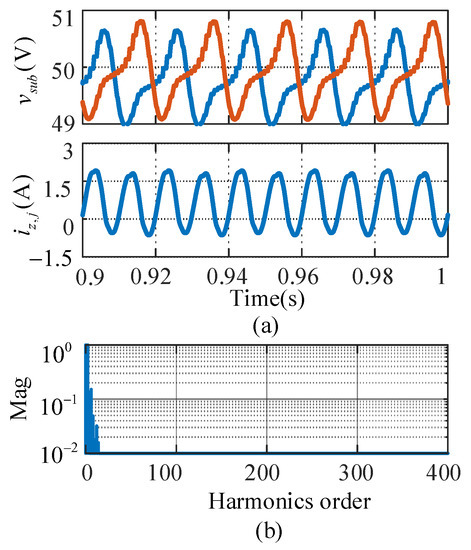
Figure 17.
Simulation results of PSC4. (a) Capacitor voltage of SMs and circulating current. (b) FFT analysis of circulating current.

Figure 18.
Simulation results of PSC5. (a) Capacitor voltage of SMs and circulating current. (b) FFT analysis of circulating current.
As shown in Figure 16, PSC3 caused the deviation and unbalance of capacitor voltage because large even side-band harmonics around the carrier frequency (especially h18, h20, and h22) remained in circulating current with PSC3, which were also contained in switching function of SMs. These harmonic components caused a non-negligible DC current in the capacitor of the SMs. This phenomenon can also be intuitively understood from the number of submodules connected to each phase. Unlike other solutions, 0 to SMs could be put into a phase with PSC3. From (1), when SMs were inserted, voltage across the arm inductors was , causing high circulating current and unstable SM capacitor voltages. Therefore, the selection of and needs to consider the harmonic-cancellation characteristic of both output voltage and circulating current. PSC1 and PSC4 when are the optimal output-voltage harmonic minimization PSC-SPWM scheme and the optimal circulating current harmonic minimization PSC-SPWM scheme, respectively, with a stable and balanced capacitor voltage.
4.2. Experiment Results
Figure 19 shows the experiment results with PSC1, where displacement angles were selected as and . Experiment results were almost identical to the simulation results, including output-voltage levels, the harmonic distribution of output voltage and circulating current, and the voltage stability of capacitors; voltage levels were generated, and output THD was 13.75%, which was close to the theoretical 14.71%. Simultaneously, high-frequency harmonic groups (mainly side-band harmonics around -multiples carrier frequency) remained in the circulating current, which was calculated by a mathematical function of an oscilloscope according to (2). The peak value of circulating current was approximately equal to 1.5 A capacitor voltage of SMs in the top and bottom arms, which were naturally balanced with small fluctuation.
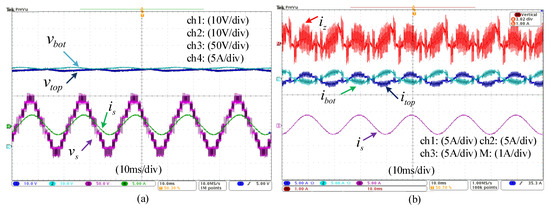
Figure 19.
Experiment results with PSC1. (a) Phase voltage , phase current , capacitor voltage of SM and ; (b) circulating current , phase current , arm current , and .
Figure 20 shows the experiment results with PSC2, where displacement angles were selected as and . PSC2 achieved the same characteristics as those of PSC1. The equivalence of PSC1 and PSC2 was verified as analyzed before, and only SMs corresponding to the top and bottom arms were different; the proposed PSC1 unified two different cases of odd and even SM situations for maximal harmonic elimination of output voltage.
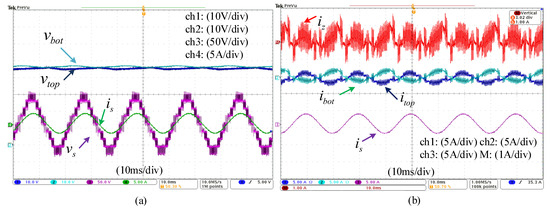
Figure 20.
Experiment results with PSC2. (a) Phase voltage , phase current , capacitor voltage of SM and ; (b) circulating current , phase current , arm current and .
Figure 21 shows the experiment results with PSC3, where displacement angles were selected as and . Only three levels of output voltage were generated. Theoretical output-voltage levels could not be achieved because the capacitor voltage of SMs deviated to or 0, which was consistent with the simulation results. This is a validation that PSC3 is not acceptable for industrial applications, and should be guaranteed for PSC-SPWM schemes.
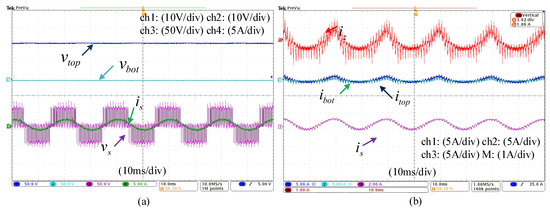
Figure 21.
Experiment results with PSC3. (a) Phase voltage , phase current , capacitor voltage of SM and ; (b) circulating current , phase current , arm current and .
Figure 22 shows the experiment results with PSC4, where displacement angles were selected as and . Experiment results were almost identical to the simulation results; voltage levels were generated, and output THD was 32.42%, which was close to the theoretical 36.23%. Simultaneously, all high-frequency harmonic groups were completely eliminated in the circulating current, and the peak value of the circulating current was approximately equal to 0.5 A, which was smaller than that with PSC1 and PSC2. Capacitor voltages of SMs in the top and bottom arms were naturally balanced with small fluctuation. PSC4 when caused the deviation and unbalance of capacitor voltage because of the same reason as that for PSC3.
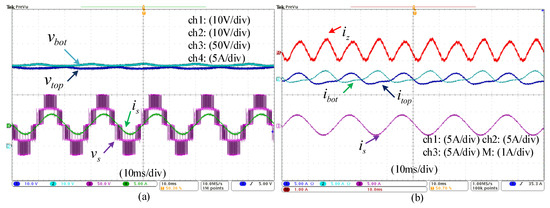
Figure 22.
Experiment results with PSC4 when . (a) Phase voltage , phase current , capacitor voltage of SM and ; (b) circulating current , phase current , arm current and .
Figure 23 shows the experiment results with PSC5, where displacement angles were selected as and . PSC5 achieved the same characteristics as those of PSC4. PSC4 and PSC5 were equivalent as analyzed before, and only SMs corresponding to the top and bottom arms were different. The proposed PSC4 when could unify two different cases of odd and even SM situations for the maximal harmonic elimination of the circulating current.
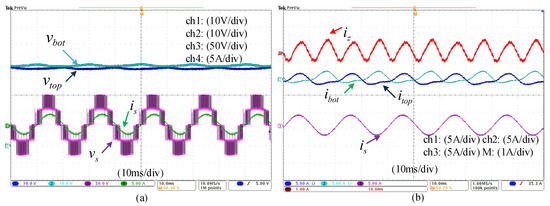
Figure 23.
Experiment results with PSC5. (a) Phase voltage , phase current , capacitor voltage of SMs and ; (b) circulating current , phase current , arm current and .
The PSC-SPWM of MMC is different from that of CHB, and only those SMs in the identical arm are equivalent. In order to avoid deviation of capacitor voltage, the selection of and needs to consider harmonic cancellation characteristics of both output voltage and circulating current. A comparison of five PSC-SPWM schemes is listed in Table 2. Considering these facts and implementations, PSC1 (, ) is the most suitable PSC-SPWM scheme in practical applications when the number of SMs is small. Only odd side-band harmonics around -multiples carrier frequency remained in output voltage, and even side-band harmonics around -multiples carrier frequency remained in circulating current; at the same time, the capacitor voltage of SMs was stable and balanced. On the other hand, PSC4 (, ) is the most suitable PSC-SPWM scheme in practical applications when the number of SMs is large. Only side-band harmonics around -multiples carrier frequency remained in output voltage, and all carrier-frequency harmonics were eliminated in circulating current; at the same time, the capacitor voltage of SMs was stable and balanced. Moreover, the implementations of both PSC1 and PSC4 when do not need irregular change with the parity of submodule number.

Table 2.
Comparison of five PSC-SPWM schemes.
5. Conclusions
This paper provided theoretical and experimental discussions on the characteristics of the modular multilevel converter (MMC) when phase-shifted carrier sinusoidal pulse width modulation (PSC-SPWM) is applied. The harmonic components of output phase voltage and circulating current were derived in detail. We also analyzed how the displacement angle between SM carriers affects the harmonic-cancellation characteristics of output voltage, circulating current, and capacitor voltage of SMs. Displacement angles were found to affect the harmonic magnitudes of both output voltage and circulating current. On the basis of analysis, five potential PSC-SPWM schemes with maximal harmonic-cancellation ability for output voltage or circulating current were proposed. Furthermore, capacitor voltages affected by PSC-SPWM schemes were analyzed. Optimal displacement angles were selected for minimizing the harmonics of output voltage and circulating current that are suitable for application with a low and high number of SMs. Lastly, the mathematical analysis and proposed schemes were verified by simulation and experiments on a low-power MMC prototype.
Author Contributions
Conceptualization, C.W. and Q.C.; methodology, Q.C.; software, Q.C. and J.W.; validation, Q.C.; formal analysis, Q.C.; investigation, Q.C.; resources, J.W.; data curation, Q.C.; writing—original-draft preparation, Q.C.; writing—review and editing, Q.C., C.W. and J.W.; visualization, Q.C.; supervision, C.W.; project administration, C.W.; funding acquisition, C.W. All authors have read and agreed to the published version of the manuscript.
Funding
This research received no external funding.
Acknowledgments
We thank all the journal editors and the reviewers for their valuable time and constructive comments that have contributed to improving this manuscript.
Conflicts of Interest
The authors declare no conflict of interest.
References
- Lesnicar, A.; Marquardt, R. An innovative modular multilevel converter suitable for a wide power range. In Proceedings of the 2003 IEEE Bologna Power Tech Conference Proceedings, Bologna, Italy, 23–26 June 2003; Volume 3, p. 6. [Google Scholar]
- Dekka, A.; Wu, B.; Fuentes, R.L.; Perez, M.; Zargari, N.R. Evolution of Topologies, Modeling, Control Schemes, and Applications of Modular Multilevel Converters. IEEE Trans. Emerg. Sel. Topics Power Electron. 2017, 5, 1631–1656. [Google Scholar] [CrossRef]
- Zhang, J.; Xu, S.; Din, Z.; Hu, X. Hybrid Multilevel Converters: Topologies, Evolutions and Verifications. Energies 2019, 12, 615. [Google Scholar] [CrossRef]
- Solas, E.; Abad, G.; Barrena, J.A.; Aurtenetxea, S.; Cárcar, A.; Zając, L. Modular Multilevel Converter With Different Submodule Concepts—Part II: Experimental Validation and Comparison for HVDC Application. IEEE Trans. Ind. Electron. 2013, 60, 4536–4545. [Google Scholar] [CrossRef]
- Yang, X.; Xue, Y.; Chen, B.; Lin, Z.; Mu, Y.; Zheng, T.Q.; Igarashi, S.; Li, Y. An enhanced reverse blocking MMC with DC fault handling capability for HVDC applications. Electr. Power Syst. Res. 2018, 163, 706–714. [Google Scholar] [CrossRef]
- Bina, M.T. A Transformerless Medium-Voltage STATCOM Topology Based on Extended Modular Multilevel Converters. IEEE Trans. Power Electron. 2011, 26, 1534–1545. [Google Scholar]
- Cupertino, A.F.; Farias, J.V.M.; Pereira, H.A.; Seleme, S.I.; Teodorescu, R. Comparison of DSCC and SDBC Modular Multilevel Converters for STATCOM Application During Negative Sequence Compensation. IEEE Trans. Ind. Electron. 2019, 66, 2302–2312. [Google Scholar] [CrossRef]
- Chen, Y.; Zhao, S.; Li, Z.; Wei, X.; Kang, Y. Modeling and Control of the Isolated DC–DC Modular Multilevel Converter for Electric Ship Medium Voltage Direct Current Power System. IEEE Trans. Emerg. Sel. Topics Power Electron. 2017, 5, 124–139. [Google Scholar] [CrossRef]
- Hagiwara, M.; Nishimura, K.; Akagi, H. A Medium-Voltage Motor Drive With a Modular Multilevel PWM Inverter. IEEE Trans. Power Electron. 2010, 25, 1786–1799. [Google Scholar] [CrossRef]
- Sau, S.; Fernandes, B.G. Modular Multilevel Converter Based Variable Speed Drive With Reduced Capacitor Ripple Voltage. IEEE Trans. Ind. Electron. 2019, 66, 3412–3421. [Google Scholar] [CrossRef]
- Ma, F.; Xu, Q.; He, Z.; Tu, C.; Shuai, Z.; Luo, A.; Li, Y. A Railway Traction Power Conditioner Using Modular Multilevel Converter and Its Control Strategy for High-Speed Railway System. IEEE Trans. Transp. Electrif. 2016, 2, 96–109. [Google Scholar] [CrossRef]
- Wang, Z.; Zheng, Z.; Li, Y.; Li, G. Modulation and Control Strategy for Electric Traction Drive System of Rail Transit Vehicles. Trans. China Electrotech. Soc. 2016, 31, 223–232. [Google Scholar]
- Konstantinou, G.; Pou, J.; Ceballos, S.; Darus, R.; Agelidis, V.G. Switching Frequency Analysis of Staircase-Modulated Modular Multilevel Converters and Equivalent PWM Techniques. IEEE Trans. Power Del. 2016, 31, 28–36. [Google Scholar] [CrossRef]
- Samajdar, D.; Bhattacharya, T.; Dey, S. A Reduced Switching Frequency Sorting Algorithm for Modular Multilevel Converter With Circulating Current Suppression Feature. IEEE Trans. Power Electron. 2019, 34, 10480–10491. [Google Scholar] [CrossRef]
- Tu, Q.; Xu, Z.; Xu, L. Reduced Switching-Frequency Modulation and Circulating Current Suppression for Modular Multilevel Converters. IEEE Trans. Power Del. 2011, 26, 2009–2017. [Google Scholar]
- Pérez-Basante, A.; Ceballos, S.; Konstantinou, G.; Pou, J.; Andreu, J.; de Alegría, I.M. (2N+1) Selective Harmonic Elimination-PWM for Modular Multilevel Converters: A Generalized Formulation and A Circulating Current Control Method. IEEE Trans. Power Electron. 2018, 33, 802–818. [Google Scholar] [CrossRef]
- Dekka, A.; Wu, B.; Zargari, N.R.; Fuentes, R.L. A Space-Vector PWM-Based Voltage-Balancing Approach With Reduced Current Sensors for Modular Multilevel Converter. IEEE Trans. Ind. Electron. 2016, 63, 2734–2745. [Google Scholar] [CrossRef]
- Ronanki, D.; Williamson, S.S. A Simplified Space Vector Pulse Width Modulation Implementation in Modular Multilevel Converters for Electric Ship Propulsion Systems. IEEE Trans. Transp. Electrif. 2019, 5, 335–342. [Google Scholar] [CrossRef]
- Ilves, K.; Harnefors, L.; Norrga, S.; Nee, H. Analysis and Operation of Modular Multilevel Converters with Phase-Shifted Carrier PWM. IEEE Trans. Power Electron. 2015, 30, 268–283. [Google Scholar] [CrossRef]
- Zhou, D.; Yang, S.; Tang, Y. Model-Predictive Current Control of Modular Multilevel Converters With Phase-Shifted Pulsewidth Modulation. IEEE Trans. Ind. Electron. 2019, 66, 4368–4378. [Google Scholar] [CrossRef]
- Sasongko, F.; Sekiguchi, K.; Oguma, K.; Hagiwara, M.; Akagi, H. Theory and Experiment on an Optimal Carrier Frequency of a Modular Multilevel Cascade Converter With Phase-Shifted PWM. IEEE Trans. Power Electron. 2016, 31, 3456–3471. [Google Scholar] [CrossRef]
- Li, B.; Yang, R.; Xu, D.; Wang, G.; Wang, W.; Xu, D. Analysis of the Phase-Shifted Carrier Modulation for Modular Multilevel Converters. IEEE Trans. Power Electron. 2015, 30, 297–310. [Google Scholar] [CrossRef]
- Cheng, Q.; Wang, C. Comparison of Phase-Shifted Carrier PWM Schemes for Modular Multilevel Converter. In Proceedings of the 2019 IEEE Energy Conversion Congress and Exposition (ECCE), Baltimore, MD, USA, 29 September–3 October 2019; pp. 4801–4807. [Google Scholar]
- Van der Merwe, W. Natural Balancing of the 2-Cell Modular Multilevel Converter. IEEE Trans. Ind Appl. 2014, 50, 4028–4035. [Google Scholar] [CrossRef]
- Lipo, T.; Holmes, D. Pulse Width Modulation for Power Converters: Principles and Practice; Wiley: Hoboken, NJ, USA, 2003. [Google Scholar]
Publisher’s Note: MDPI stays neutral with regard to jurisdictional claims in published maps and institutional affiliations. |
© 2020 by the authors. Licensee MDPI, Basel, Switzerland. This article is an open access article distributed under the terms and conditions of the Creative Commons Attribution (CC BY) license (http://creativecommons.org/licenses/by/4.0/).